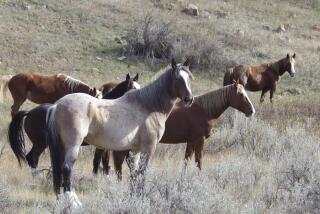Banding together for Bangladesh
Afzal Hossein knew the cyclone would hit his family’s home in Jhalokathi, Bangladesh. For days there had been news reports of the approaching storm. On Thursday he spoke by phone with his father who told him “the storm is coming, but we’re safe,” said Hossein, 38, a Los Angeles resident.
Hours later Tropical Cyclone Sidr swept through the poor South Asian nation, flooding villages, killing thousands and knocking out power lines and cellphone towers. Hossein lost touch with his family for two days.
He later learned that the balcony and kitchen of his family’s home were blown away. But his parents were fine.
“They’re now OK,” said Hossein, who remained shaken Monday as he fielded calls from other immigrants at the Consulate General of Bangladesh in Los Angeles. Going home was not an option.
“If I go home, it’s a $1,400 plane fare,” he said. “But if I send it, they can have it.”
The death toll in his homeland has reached more than 3,000, with the number expected to rise. Of the 64 districts in Bangladesh, 28 were hit, primarily in the more rural areas, affecting poor farmers and fisherman, officials said.
“The following day, the government or administration couldn’t assess the impact. . . . Trees fell everywhere. . . . It took two days to clean up the roads,” said Consul General Abu Zafar.
Zafar, whose family lives in hard-hit Patuakhali, lost four cousins, who were swept away by floodwaters. His family also lost about $220,000 worth of timber plants and other crops, he said.
The family provided shelter in their home for about 50 people during the cyclone and have been giving food and clothing to others in need, Zafar said. “I tell you frankly I couldn’t sleep for the last six days because when I spoke to [my father] on his cellphone, he was totally devastated and shaken,” he said.
The storm brought back memories of the 1970 Bhola Cyclone, which also hit in November and killed more than 300,000 people. Another storm in 1991 killed about 150,000 people.
“This is nothing new for people over there,” Zafar said.
He remembered as a 10-year-old boy in 1970 standing on the roof of his parents’ home. He saw fish and snakes swirling by in 15-foot-high swells. He also remembered seeing dead bodies.
Since the late 1970s, the government has pursued a policy of “Green Revolution,” requiring people to invest in community forestry. These trees and plants could help protect homes from a windstorm, Zafar said.
He said he has been in touch with community leaders around the U.S. to organize relief efforts.
“The immediate need of people in that area is food supply, shelter. We need to construct houses for these people,” Zafar said. “We have to feed these people for at least four to six months. There’s no buffalo or cows to plow land” because all of the farm animals were killed.
Maminul “Bacchu” Haque was spearheading the relief effort in Los Angeles. On Monday, sitting at the back of a Bangladeshi grocery store in mid-Wilshire, Haque fielded calls on two phones from people around the world seeking information about the ravaged country. He spoke loudly in his native Bengali, as he scrawled their phone numbers into a red spiral notebook.
Haque, 51, the former president of the Bangladesh Assn. of Los Angeles, was the one many turned to for news or help. There are an estimated 30,000 Bangladeshi immigrants living in Los Angeles County.
Haque had barely slept since Friday when he first heard news reports about the storm’s damage.
On Monday, he was rushing about trying to plan assistance with the consulate and local businesses. By the afternoon he had received hundreds of calls. Like many in the community, Haque had been glued to the four satellite Bangladeshi television stations that told stories of the devastation and rising death toll. “The whole night I watched television I was crying and my wife was crying,” Haque said. “Little babies have no food. . . . We need money. We need food. We need medicine.”
Community meetings on Monday solidified local support for raising funds as local leaders called on businesses and other community members to donate. Haque said Bangladeshi mom-and-pop stores would be collecting money and donations of clothing, food and water.
Meanwhile, the consulate continued to field calls from Bangladeshi expatriates, Americans, Pakistanis and many others.
“They’re asking two things: What is the situation there . . . and how can I help?” said Zahidul Haque, commercial consul of the consulate, which serves eight Western states. For more information, call (323) 932-0100 or (323) 932-0013.
Saifur “Jeetu” Osmani, West Coast correspondent for the radio program “Voice of America,” said his organization along with Kochi Konther Asar USA and Kids Vision are collecting food and medicine.
“We’re asking for all United States and Bangladeshi communities to collect toys, blankets, canned food and medicine, especially for diarrhea,” he said. He said these donations will be collected in local cities and then sent to Bangladesh from New York. For more information, call (213) 400-4948.
Back at the grocery store in mid-Wilshire, a steady stream of Bangladeshis sought out Maminul Haque’s help. A friend, Sikder Giasuddin, 48, former secretary general for the Committee for Democracy in Bangladesh, had just returned Monday from a three-month visit to Bangladesh. His family, which lives in Chittagong, had prepared for the cyclone, but the storm moved farther west.
During the weekend, Giasuddin surveyed the damage firsthand.
“It’s devastating,” he said. “You cannot imagine . . . thousands of people are homeless now.”
--
More to Read
Start your day right
Sign up for Essential California for news, features and recommendations from the L.A. Times and beyond in your inbox six days a week.
You may occasionally receive promotional content from the Los Angeles Times.






